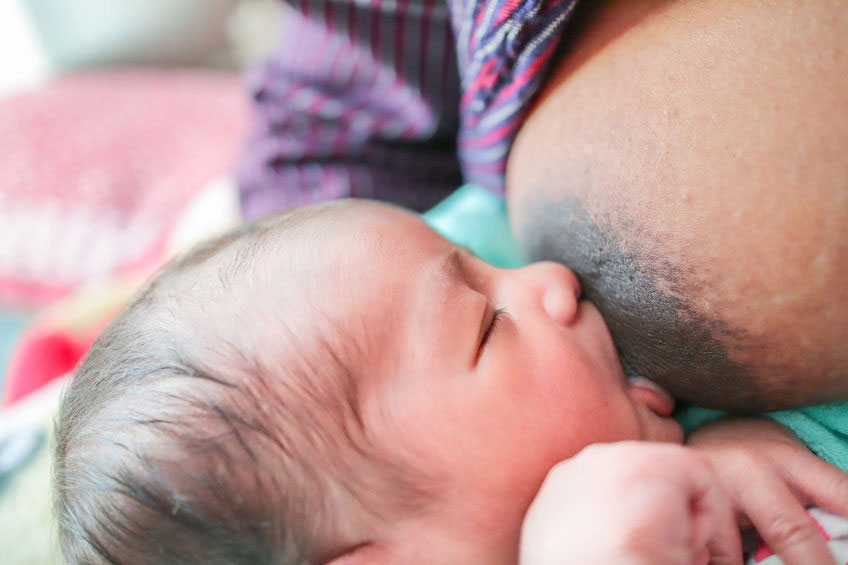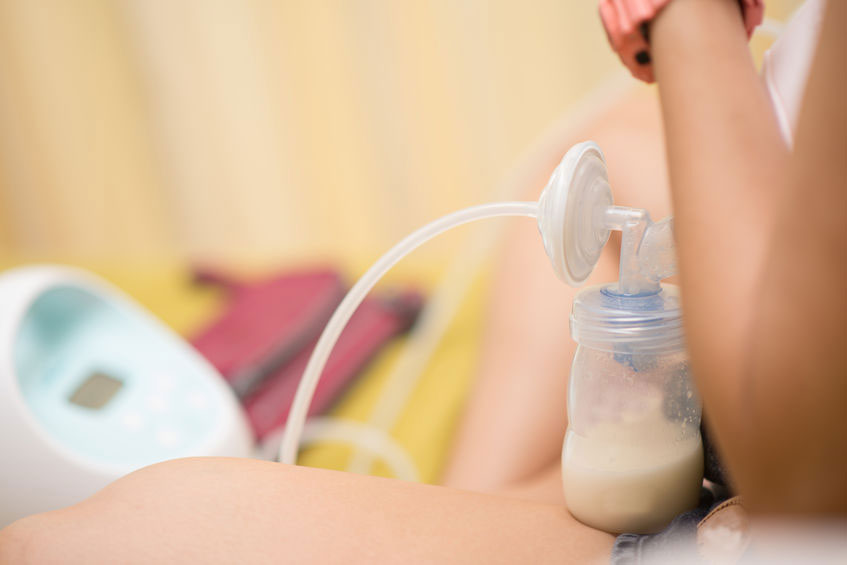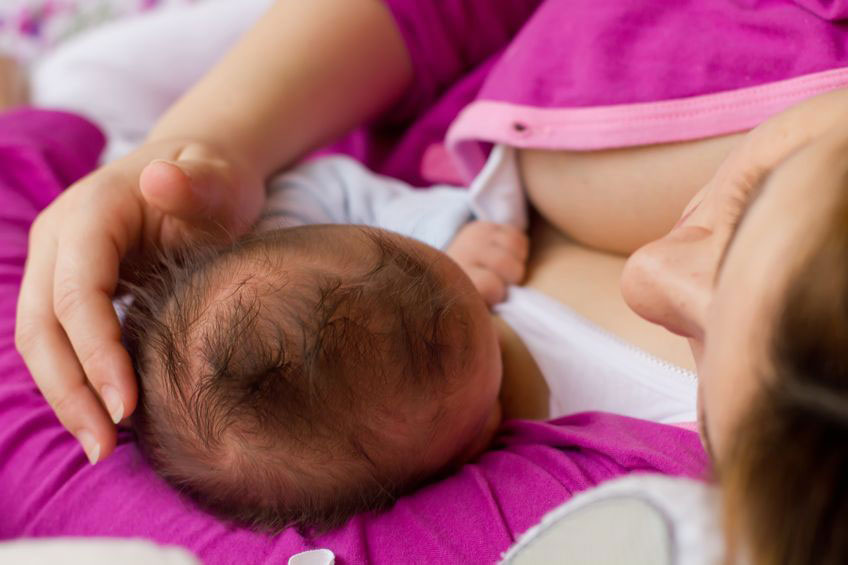Breastfeeding isn’t supposed to be painful but there are a number of reasons why it can hurt sometimes. The most likely reason is when a baby is not attached to the breast deeply with a big mouthful of breast tissue in their mouth as well as the nipple. When the mother’s nipple is too far forward in a baby’s mouth during a breastfeed it can be squeezed between baby’s tongue and palate and quickly become painfully sore.
Once a baby can be helped to latch deeply, sore nipples caused by poor positioning or attachment (latch) usually heal quickly on their own. However, sometimes finding the causes of sore nipples is not easy and takes some time, and meanwhile sore nipples are a high risk factor for stopping breastfeeding early.
Are there any treatments to soothe sore nipples or is it all about positioning? This article discusses popular treatments for sore nipples from home remedies to prescription medication.
Treatments for sore nipples
There are many suggested treatments for sore nipples from adjusting the way a baby attaches to the breast, to using lanolin, nipple shields or prescription ointments. What works for one mother may not work for another and strategies will depend on the cause of the sore nipples. In addition to poor positioning and attachment, sore nipples may be due to dermatitis, eczema, psoriasis or even caused by an allergy or side effect of a topical cream you have already been using. If nipples are cracked, blistered or damaged there could be a possibility of an infection which may require medication from your doctor. Always check with your health professional if you have very sore nipples that are not healing.
Popular treatments
Popular treatments are discussed below but note that apart from #1 Check positioning and attachment—which is universally accepted as important—there isn’t enough evidence to recommend one treatment option over another. What helps one mother may not help another and some treatments for sore nipples may even make symptoms worse.

#1 Check positioning and attachment
The number one “treatment” is to find and solve the cause of your sore nipples with the help of your IBCLC lactation consultant and health care professional. In most cases the way your baby is attaching to the breast (latching) or the way you are holding your baby to breastfeed (positioning) will be the reason why your nipples are sore. Causes of Sore Nipples and Why Does Breastfeeding Hurt? run through a selection of reasons for sore nipples and include links to articles that can help with improving positioning and attachment.
#2 Check equipment and gadgets
If you are regularly using any pumping equipment, this could also be a cause of sore nipples; for example if the pump flange is not the right size for your nipple or the pump suction is too high.
#3 Wash with plain soap
In Are There Any Cures for Sore Nipples? Marsha Walker IBCLC says washing damaged nipples with ordinary mild soap (not antibacterial) once a day keeps any wounds clean, reduces the number of bacteria present and breaks down the bacteria’s protective shield. This shield (biofilm) is said to protect the bacteria from the mother’s immune system and from antibiotic treatment. With the shield disrupted, topical antibiotic may reach the affected area more easily.1 Note; there’s no need to wash healthy nipples with soap. Buchanan et al2 caution that washing with soap can dry the skin and lactation consultant/breast surgeon Katrina Mitchell points out that soap can be a cause of dermatitis and skin breakdown3.
#4 Treatments for dermatitis, eczema and psoriasis
Common causes of sore nipples include the skin conditions; dermatitis, eczema and psoriasis. A health professional can help with diagnosis of these skin conditions and suggest medication compatible with breastfeeding. In Managing Common Breastfeeding Problems in the Community, BMJ, 2014, Dr Lisa Amir explains that a mother may be predisposed to these skin conditions or they might appear as a reaction to certain topical creams used on the nipple or even following using a breast pump. Symptoms typically include pain and itching with reddening of the skin and may include flaking or crusting. Amir’s treatment plan for eczema, dermatitis and psoriasis includes:
Treatment includes application of a moderately strong corticosteroid, such as mometasone, once daily and sparingly after a feed (no need to be washed off) for up to 10 days. When crusting is a feature, the dermatitis is likely to be colonised with S aureus, and mupirocin ointment can be added.
The article Medications and Breastfeeding lists several online resources for checking the latest compatibility of medications with breastfeeding, which can be discussed with your health professional.
#5 Medical treatments for damaged nipples
Marsha Walker IBCLC compared various sore nipple treatments and she concluded that many home remedies (see #7 below) do not have very good evidence for their use (Walker, 2013). However since natural or household treatments do not generate big money, there is often little incentive to research them and more incentive to skew results towards a commercial product. Walker proposes the following medical based treatment plan for cracked or damaged sore nipples:
- Correct positioning and latch
- If there is broken skin; wash nipples daily with soap and water and apply a topical antibiotic (mupirocin) to treat any bacterial infection (eg. staph) and a topical low strength steroid for inflammation. Avoid using a dummy (pacifier), if used, wash it thoroughly with soap and water.
- If there is a fluid discharge or pus or very red skin without a dry scab; systemic antibiotics are recommended. If thrush (Candida albicans) is a possibility, add an antifungal agent (topical 2% miconazole).
- If the infection doesn’t respond to the above; treat the baby with nasal mupirocin because he may be a carrier of the bacteria Staphylococcus aureus and may infect or reinfect the mother’s nipple.4 Test for genetic variations (small colony variants) of staphylococci bacteria. If they are present, use the appropriate antibiotics, be vigilant for mastitis and check for anaemia (Walker, 2013).
NICE guidelines
A similar protocol for sore, damaged nipples from NICE (UK) recommends using antibiotic cream fusidic acid (or mupirocin if antimicrobial resistance is likely) for suspected bacterial infection, antifungal cream (miconazole 2%) for suspected Candida infection and hydrocortisone 1% cream if nipples are red and inflamed.5
Note. Newer thinking questions the evidence base behind the existence of fungal infections of the nipple such as Candida (thrush).678
All purpose nipple ointment
Canadian paediatrician and breastfeeding specialist Jack Newman also has a similar protocol for sore nipples with his All Purpose Nipple Ointment (APNO) which contains a topical antibiotic, anti inflammatory and antifungal in one treatment. However, not all authors are convinced about applying topical creams to nipples including APNO.9 One study of 151 women suggested that APNO wasn’t more effective for treating painful damaged nipples than using lanolin10 and another did not find that APNO significantly improved mothers’ pain.11 Doctor, breast surgeon and IBCLC Katrina Mitchell urges against using APNO saying that the various ingredients can cause allergy and other complications and that it is the steroid component that provides pain relief.12

#6 Moist wound healing
Covering a wound with a dressing that excludes air and water facilitates something called “moist wound healing”. Moist wound healing is said to increase the speed of healing, reduce scab formation and reduce pain. It is often recommended that moist wound healing is helpful for sore or cracked nipples and products commonly used as a dressing are purified lanolin (applied as an ointment), hydrogel dressings and petroleum based products eg vaseline.
Different opinions
Opinions differ on how effective moist wound healing products are (Buchanan et al., 2019). Douglas cautions that dry scab formation is part of normal healing of a wound, and that moist wound healing can cause overhydration and moisture associated skin damage of a lactating nipple and areola particularly when using petroleum based products (Douglas, Vol 18: 1–29 2022). Douglas reviews the research around moist wound healing of nipples in Appendix 2 of Re-thinking lactation-related nipple pain and damage 2022 and concludes that research doesn’t support manufacturer’s claims that lanolin or hydrogel have healing benefits for nipples.
Purified lanolin
Some mothers find purified lanolin helpful for sore nipples. Lanolin is a substance extracted from sheep’s wool. Contaminants, detergent and pesticide residues are allegedly removed from ultra purified lanolin and only the smallest smear is needed on a sore nipple.13
Mothers using lanolin should be aware that:
- Allergies to lanolin are possible. Despite the purification process, some mothers find they have a reaction to lanolin making their sore nipples worse. Mothers with an allergy to wool are advised to avoid using it.14 Photographs of a nipple with a classic allergy to lanolin can be seen in Dr Katrina Mitchell’s Yeast Infection While Breastfeeding?
- Skin breakdown. Applying a topical product including lanolin to the nipple risks moisture associated skin damage (sore nipples) which may be confused with being allergic to the product (Douglas, Vol 18: 1–29 2022).
- Lanolin may increase nipple infections. According to one researcher lanolin on nipples may be associated with nipple infections and they called for more research to establish whether lanolin is a growth medium for infection particularly if the mother has a history of antibiotic use during childbirth.15
- Lanolin could make the nipple and areola slippery and mask the scent from the montgomery glands which are thought to help a baby locate the nipple.16 Try to use the smallest amount possible.
- More studies are needed. Despite the popularity of lanolin several studies have not found it to be consistently more effective than other frequently used remedies and more good studies are needed.17
Hydrogel dressings
Commercially made hydrogel dressings have a high water content which are said to cool a wound and provide a moist healing environment. Hydrogel dressings are applied to the nipple between feeds and must be washed off before a feed (Douglas, Vol 18: 1–29 2022). Marsha Walker explains:
These dressings are water based and often a combination of water and glycerin in a polymer matrix. Their value lies in their ability to maintain moisture, inhibit scab or crust formation, reduce pain, and enhance epithelial migration for wound repair.
Hydrogel dressings may be a possible option in the treatment of nipples with open sores or cracks with exudate. The dressing absorbs wound discharge and prevents the nipple skin from adhering to the mother’s bra.
Wilson-Clay and Hoover point out that wet and dirty hydrogel pads expose nipple cracks to pathogens and do not help healing; careful hygiene is important ie with hand washing and frequent changes of the dressing when they turn cloudy.18 Douglas cautions against over hydration and skin breakdown (Douglas, Vol 18: 1–29 2022).

#7 Home remedies
The following are some popular remedies for sore nipples. Several authors conclude that many natural treatments do not have very good evidence for their use (Walker 2013; Douglas, Vol 18: 1–29 2022) however some mothers find them helpful. Bear in mind that any individual product may cause allergic symptoms for a particular mother or cause sore nipples due to moisture associated skin damage (Douglas, Vol 18: 1–29 2022).
Warm water compresses
Warm water compresses were shown in one study to be more effective at soothing sore nipples than lanolin or breast milk19 and another study suggested warm water compresses may help with pain relief.20 Warm water may help blood flow to the area and help remove waste products.21
Salt water (saline)
Walker states that a variation of the warm water compress above is to use a saline compress for ten minutes (Walker, 2013). A saline solution is a mixture of salt and water; “normal saline” is similar to body fluids such as tears. Walker suggests using a quarter to a half a teaspoon of salt to a litre (35oz) of warm water for the compress (Walker 2013). Kelly Bonyata discusses using half a teaspoon of salt to one cup of water (8oz or 236ml) as a soak for nipples for a minute or so but no more than 5-10 minutes as this may cause more cracking.22 Fernandez and Griffiths found that clean tap water may be as effective as saline for wound cleaning23 while Douglas states that salt water may cause pain and stinging without any benefit (Douglas, Vol 18: 1–29 2022)
Breast milk
Breast milk is a popular choice often suggested for rubbing into sore nipples to aid healing.24 Breast milk is full of anti infective factors that can combat bacteria. However if breast milk contains allergens that the mother is sensitive to, it may not be so calming (Minchin, 2015). Breast milk is also mostly water and keeping nipples wet could contribute to skin breakdown (Douglas, Vol 18: 1–29 2022).
Virgin coconut oil
Virgin coconut oil is credited with antibacterial, antifungal, anti-inflammatory and analgesic properties.2526272829 On the safety of virgin coconut oil, Thomas Hale breastfeeding and medications author writes on a forum:
Coconut oil, commonly called MCT oil (medium chain triglyceride), is commonly used in our NICUs to add fat into the diet of premature infants. It consists primarily of 6-12 carbon atom free fatty acid triglycerides which are easily digested by all neonates and older children. It is an ideal triglyceride for infants.
As a pure oil, it has virtually no allergenic compounds. So, if you use a high grade Coconut oil, I would not be worried about its use at all, or worry about allergies.
That said, I don’t see how it would be any better as an emollient than lanolin.
Medihoney
Medihoney is said to penetrate biofilms and be antibacterial, including against methicillin resistant Staphylococcus aureus (MRSA). Medihoney is not the usual food grade honey it is a medical grade honey product made from Leptospermum plant species. Botulism spores may be present in normal honey and honey is not recommended for babies under 12 months of age. Marsha Walker IBCLC reports that anecdotally Medihoney is thought helpful for healing sore nipples and states that it has been treated to remove botulism spores.30 However check with your health professional on the advisability of using this product if you have a baby younger than 12 months.
Peppermint
Peppermint is thought to help skin heal and have antibacterial and anti-inflammatory qualities (Walker, 2013). Two studies found that using topical peppermint water on the nipples resulted in less cracked nipples than using expressed breast milk.3132 Another study found less cracked nipples when using peppermint gel compared to lanolin or a placebo33 while another found peppermint to be similar to using lanolin/dexpanthenol creams 34. For the latest information on the safety of using peppermint containing preparations on the nipple, see the entries for peppermint at e-lactancia and LactMed who both recommend removing peppermint preparations from nipples before each breastfeed.
Commercial nipple creams
Used routinely, commercial nipple creams may alter the pH of the nipple and areola or block the Montgomery glands—reducing both the natural protective factors in the areola and the odours that guide baby to latch to the nipple (Sasaki, et al, 2014). In addition, it is not always clear whether commercial creams with multiple ingredients are safe for mother and baby (Walker, 2013). Douglas expresses concerns that topical creams can cause epidermal over-hydration and moisture associated skin damage with no evidence of benefit (Douglas, Vol 18: 1–29 2022).
Silver cups?
Purpose made solid silver cups (nipple covers) are available to buy to wear over sore, cracked nipples as a healing treatment. Silver cups are thought to potentially aid nipple healing because silver is naturally antibacterial and antifungal however it may still trigger allergic reactions.35 Internet searches reveal mixed anecdotal opinion and little evidence around using silver nipple cups for sore nipples. Some mothers have found that using silver nipple cups kept their nipples and the skin below the cups constantly moist or soggy which prevented healing. The Breastfeeding Atlas states that more research is needed to determine if silver-impregnated caps are effective for healing sore nipples but cites one small study that found positive results.36 Colloidal silver treatments are not recommended for sore nipples as they could be harmful for the baby. 37
#8 Nipple shields
Although not a treatment or cure as such, modern silicone nipple shields can be helpful in relieving the pain of sore nipples by protecting the nipple. This may make it bearable for a mother to continue breastfeeding while she seeks specialist help with positioning, while her nipples heal or if she has flat or inverted nipples. Nipple shields also have a place as a suck training tool in certain situations e.g. for babies who are retracting their tongues. For more information see Nipple Shields Good or Bad?
#9 Low level laser therapy
Low level laser therapy has been used to speed up wound healing in medicine for a long time. It is a form of light therapy that stimulates cell healing mechanisms. A number of studies suggest that this therapy can also be a helpful treatment for sore nipples. Low level laser therapy is said to speed up the healing of nipple damage and ease pain when coupled with conventional breastfeeding help such as improved positioning, or treatment for bacterial or fungal infections.383940 One clinical trial at a hospital in Brazil found that low level laser therapy reduced the intensity of pain and helped to prolong breastfeeding41 and another study with a control group also found low level laser therapy provided pain relief42. Some National Health Trusts or private clinics may offer low level laser therapy however it is still important to address the initial causes of nipple damage with a breastfeeding specialist.

Summary
The most common cause of sore nipples while breastfeeding is when a baby is not latched correctly. Once the latch is improved, sore nipples will quickly heal on their own. However if the problem continues, nipples can soon become painfully cracked and have a higher risk of infection. There are many treatments for sore nipples available but they can vary widely in how effective they are and some remedies may even be part of the problem. There is currently not enough evidence to recommend one treatment over another.43 Contact your IBCLC lactation consultant and health care provider with ongoing sore nipples so that you can get the best breastfeeding help and support to find the right treatment.